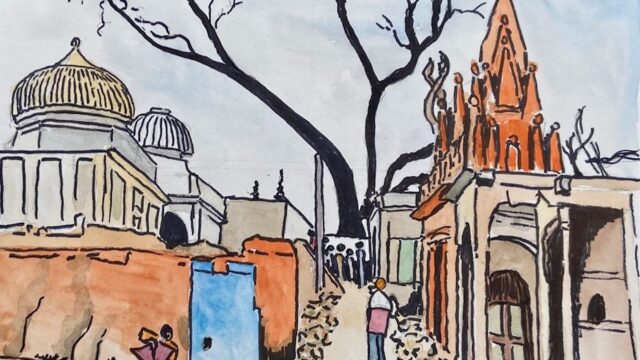
Blog 7. Varanasi – Sunrise on the Ganges and elevation to President
Day 5 Monday 18th November 2019
After only 4 hours sleep we were up and back on mother Ganges for a sunrise rowboat trip.
Our wooden boat and puny rower met us at the steps to the hotel. If yesterday’s rowing wallah looked in need of a good meal, this very youthful version didn’t look up to his task. Apparently the boat was not performing well; he really struggled to keep any momentum against the flow of the river.
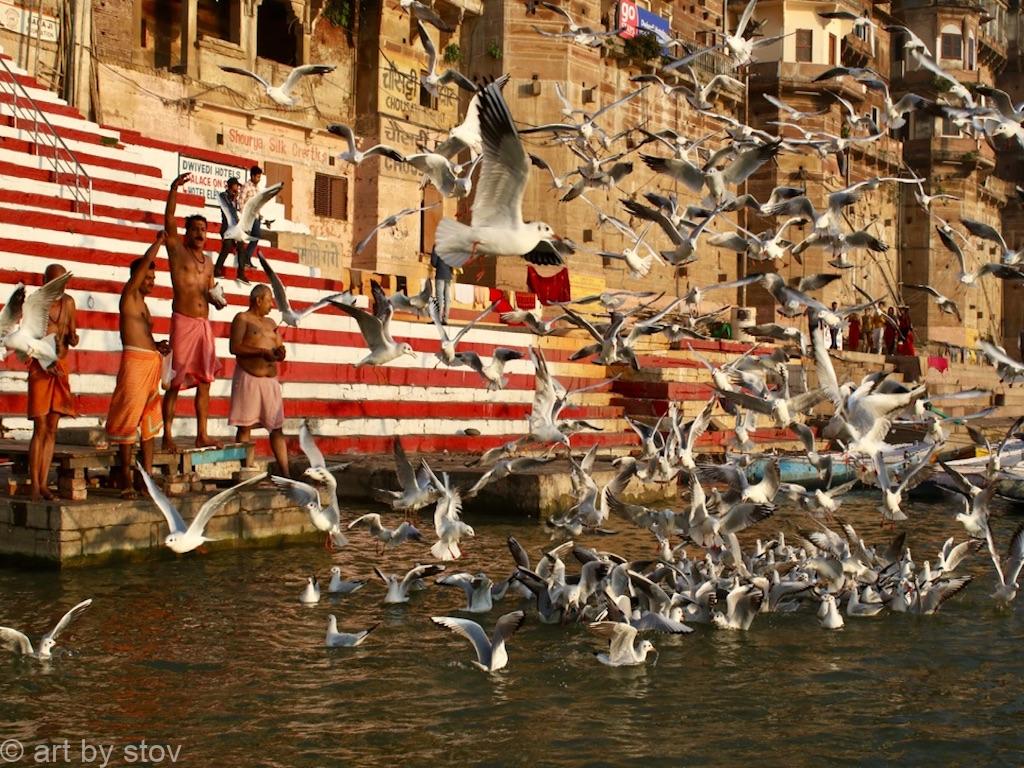
On the way up the river we saw flock upon flock of first winter Black and Brown headed Gulls. They migrate up the river from the coast for the winter and follow the many boats in expectation of food.
By yelling and waving arms they are attracted for the merest scrap of food.
From the river we also saw Black Kite, Common Mynah and an Indian pond heron scudding along amongst the ropes tethering the moored boats.
The sun rose across the river from the city and was quite spectacular, especially with the silhouettes of the bird against the fiery orange sky. At the far side of the river was a massive sandbank which must have been easily 25 foot above the river level. Apparently during monsoon this disappears as does much of riverside Varanasi!
The the puny one (our rower) got us to the Harishchandra Ghat, the cremation ghat the less well off use. There we saw a body on a litter being taken to the water’s edge for immersion and purification before cremation.
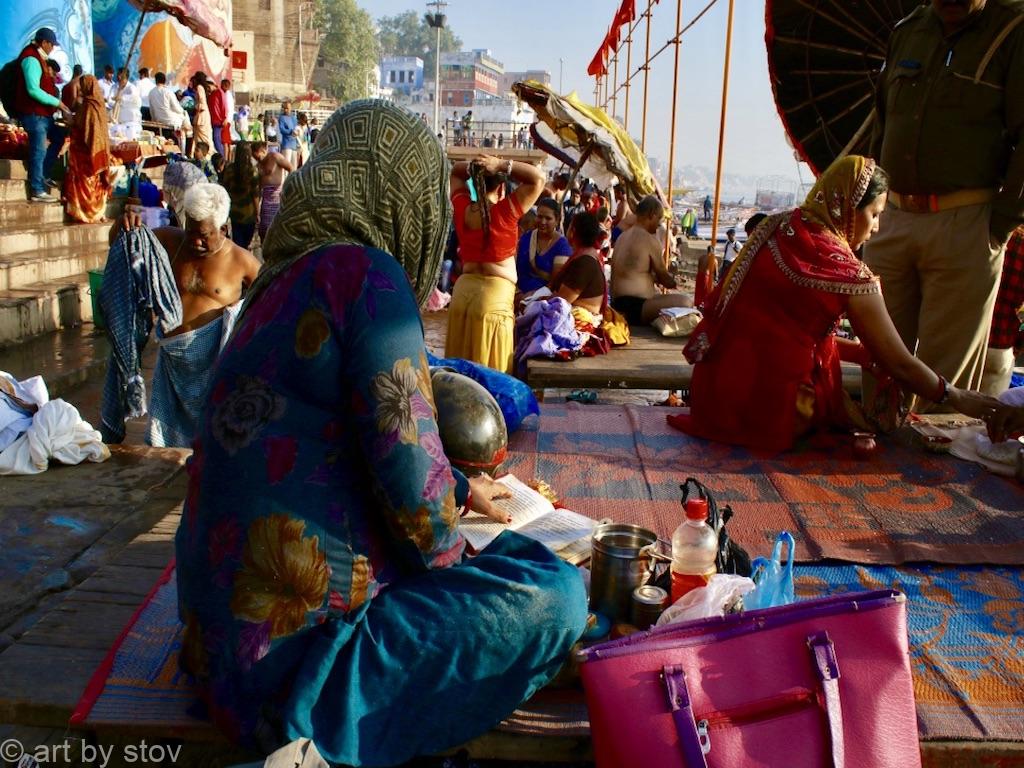
Much to the relief of the puny one we then floated down with the current to Dashashwamed Ghat where we saw the Aarti puja last night. The boats here were already stacked up ten deep and we tottered our way to shore bobbing from one to another until we alighted at the foot of a podium from the ceremony. Devout Hindus were sitting on each podia praying and reading out loud the holy scriptures. Between each bathers immersed themselves in the Ganges.
As we stepped away from the Ghat we were immersed in a world of devotion, a northern Indian family drying and clothing themselves after immersion, southern Indian ladies drizzling Coconut oil onto the stone slabs and with candles within coconuts halves. Visnuth (?) said that in the South they use oil in the temples to make the floor slippery replicating the water moistened temples in the North. The slipperiness makes the devotee concentrate more on where and how they place each footstep; it concentrates the mind.
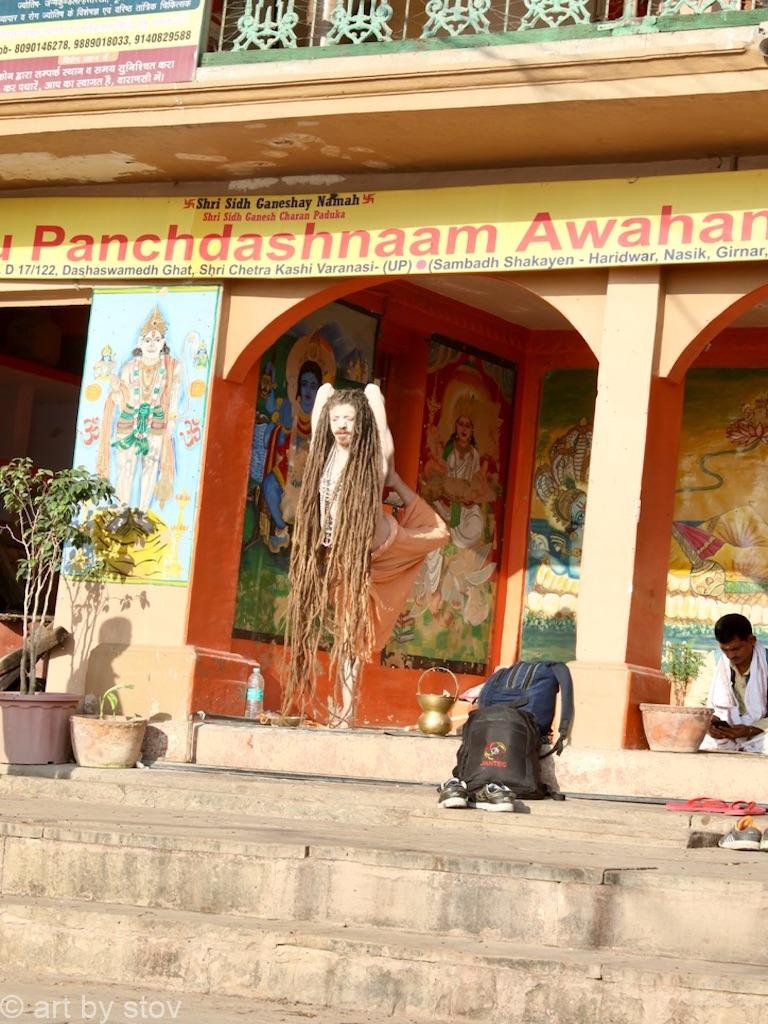
We saw our first Sadhus. Sadhus are men who devote themselves to a life of poverty and devotion. There are few genuine Sadhu and Visnuth (?) told us to look out for the fakes. One we saw looked like the genuine article, rasta locks to the ground, scantily loinclothed, body covered in ash and striking a yoga pose, which I don’t think I would have contemplated even forty years ago. As we passed on our way up into the town I spotted his backpack and Adidas trainers and heard him on his trendy phone speaking with an accent that would not have been out of place at Wigan Pier rather than riverside Varanasi. He took a biff puff on his bong and spent the next five minutes coughing!
Visnuth (?) pointed out the brown tide mark to us, 30 plus feet above the river level, on the side of the Police Station. This is the highest point the river reached this year in the monsoon floods. My thoughts wandered to where or how they held the Aarti Puja during monsoon as the site of the ceremony would have been fifteen feet or more underwater.
We headed away from the river towards the market passing more sadhus and a couple selling foot long sticks from Neem trees which are used as toothbrushes. I am familiar with Neem oil, a foul smelling organic remedy for ridding plants of pests. The thought of putting a neem stick in my mouth and chewing until it formed a brush made me cringe.
There are many venerated trees in India:
Neem – as well as health benefits is associated with the goddess Durga and is believed to keep away evil spirits.
Peepal – most worshipped as Hindus believe the roots represent Brahma, the trunk Vishnu and the leaves Shiva. Buddhists call it the Bodhi tree as it is believed the Gautam Buddha found enlightenment under such a tree. If you see a tree with a red cloth or thread around it’s trunk that will be a Peepal.
Banyan – The humble home of Krishna and the national tree of India. The roots grow down to the ground from the branches and one tree can spread over a large area in this way. On the outskirts of Kolkatta (Calcutta in old speak) there is a Banyan tree which spreads over an area of 4.67 acres.
Bael – Sacred to the lord Shiva
Ashoka – An evergreen which at distance looks rather like a poplar tree and is associated with the god of Love, the Kama Deva.
Other top picks (please forgive the pun) are the Mango, Banana, Coconut, Lotus, Sandalwood, Star Jasmine, Kadamb, Magnolia, Parijaat and a home would not apparently be complete without a Tulsi tree.
On the subject of bodily hygiene and appearance Visnuth (?) said that his hair was really grey but he dyed it with henna regularly which makes it go black. Apparently irregular use gives hair that vibrant orange look that you often see in India. You see few grey haired people in India. My brother, whose hair was virtually white from age 30, used to get mobbed when he travelled on business on the subcontinent, due to its rarity factor.
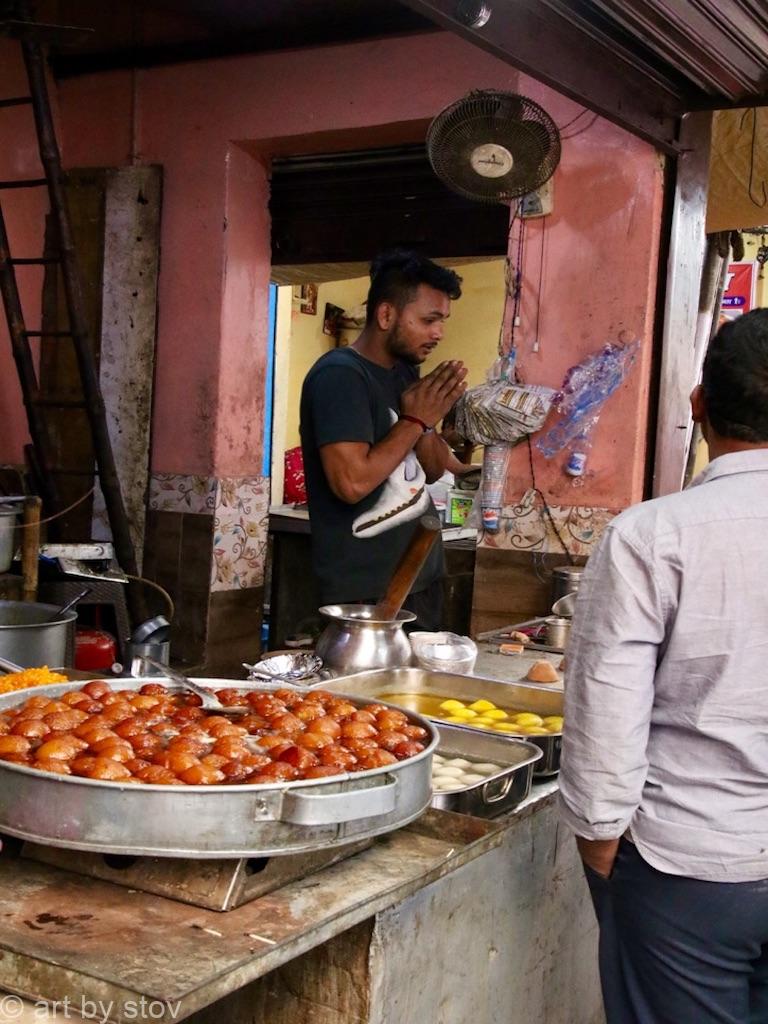
We turned right and entered the market proper. No wider than five feet, every inch of space devoted to shops and stalls selling everything and providing every service you could imagine. The street food smelled and looked incredible! To move through the market you had to mingle with the customers and the oncoming shoppers. A kaleidoscopic path of colour, sights and smells.
The market twisted and turned with even smaller side “streets” leading off in each direction. We started to climb. As we approached the brow of the hill Visnuth (?) told us that we could not take any photographs to the left at the top. At the summit we saw soldiers and police behind a barbed wire fenced compound. Visnuth (?) pointed out to us a Hindu temple with a gold covered canopy, shabby by comparison with its namesake in Amritsar but apparently as greatly revered. Next to it he pointed out a larger building, a mosque. Apparently, the Golden Temple is 18th century and a replica of The ancient Hindu temple which had stood for many hundreds of years where the mosque now stands. A familiar story across much of northern India. When the Muslim Moghuls became the ruling force in the 14th century they razed the Hindu temples and built their own religious buildings on the site.
The heightened security was imposed a few weeks before our trip when, after 40 years of deliberation, the Indian High Court ruled that the Mosque built by the Moghuls in another ancient city, Ayodhya was to be demolished in favour of a new Hindu temple. The mosque had been built on the demolished and ancient temple reputed to be the birthplace of Hindu god Rama (one of the incarnations of Shiva). The Muslims were to be given a piece of ground elsewhere in that city to build a new mosque but were unhappy with the ruling.
In India high tension between Muslim, Hindu and Sikh are never far below the surface. Throughout world history conquerors have imposed their traditions and style on the conquered; to stamp their authority I suppose. But all this bloodshed and torment caused by religion always has me baffled and maddens me; it is like a tinderbox waiting to burst into flame! I am a pacifist by nature and find conflict hard to bear. Dadabhai Naoroji (1825-1917) an early voice in the Indian Independence movement, once said “Whether I am a Hindu, a Mohamedan, a Parsi, a Christian, or of any other creed, I am above all an Indian. Our country is India; our nationality is Indian”. – His India, of course also included Bangladesh and Pakistan. His spirit must have been in turmoil over the religion based mass slaughter at the time of partition. Although it sounds twee I consider myself a child of the universe. I have nothing against any country and, if life exists elsewhere in the universe, any other world.
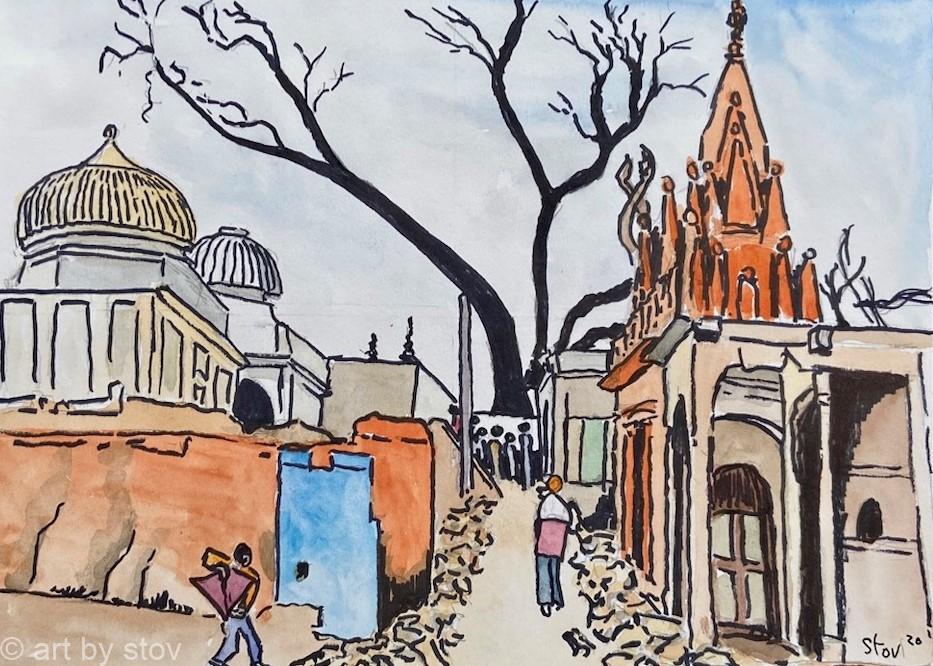
To the right of us a vast open strip of land gaped. It looked like the East End of London after a bad night in the Blitz. Piles of rubble everywhere with pointed temples standing up like jagged teeth. The current Prime Minister Narendra Modi has declared that a park should be built, approximately 100 yards across running from the top of the hill to the river. To achieve this many of the old streets of what was Kashi, the oldest part of town, were to be demolished. As the buildings are taken down they reveal the temples built into them. At a count of over 50 temples they are to be left standing.
The long term residents of Kashi still keep to what would have been the narrowest of streets as they traverse the now open ground. The government is paying five times the value of the properties demolished so that the residents can relocate out in the suburbs, scant comfort to those who have lost their communities, their businesses and their livelihoods. As we passed there was a smiling child holding his kite. At least the skies were now clear for him to fly it.
We headed back down towards the river towards the Manikarnika burning Ghat. Half way down we stopped at what seemed to be ladders propped against the wall. Then we heard a bustle of marching feet and a group of eight or so men appeared carrying horizontally a ladder. Upon the ladder was a body all wrapped in gold cloth. It passed mere inches from our noses. The deceased are marched ceremoniously around Varanasi before immersion in the holiest of waters.
Down at river level again Visnuth (?) decided to tell The ever lovely that he (that is me) and him (that is he) are like Donald Trump and Barrack Obama. We are men and we do the big jobs in life. The ever lovely and his wife are women and they do the little jobs – like shopping, cleaning and cooking. The ever lovely looked thoughtful, and replied ‘Paul does all the cooking at home’. Visnuth (?)shuffleld on the spot, looked perturbed, made a funny noise in his throat and moved on silently. We had several more amusing references to men’s big jobs and women’s little jobs before we returned to the boat.
Back across the moving bridge of boat stems and sterns with the expectation of a replacement rowing boat, we were instead greeted by a much happier puny one with a new set of oars. To be honest they looked about as effective as the first pair but looks can be deceptive. Setting to work with renewed vigour our rower made quick time getting us back to the hotel.
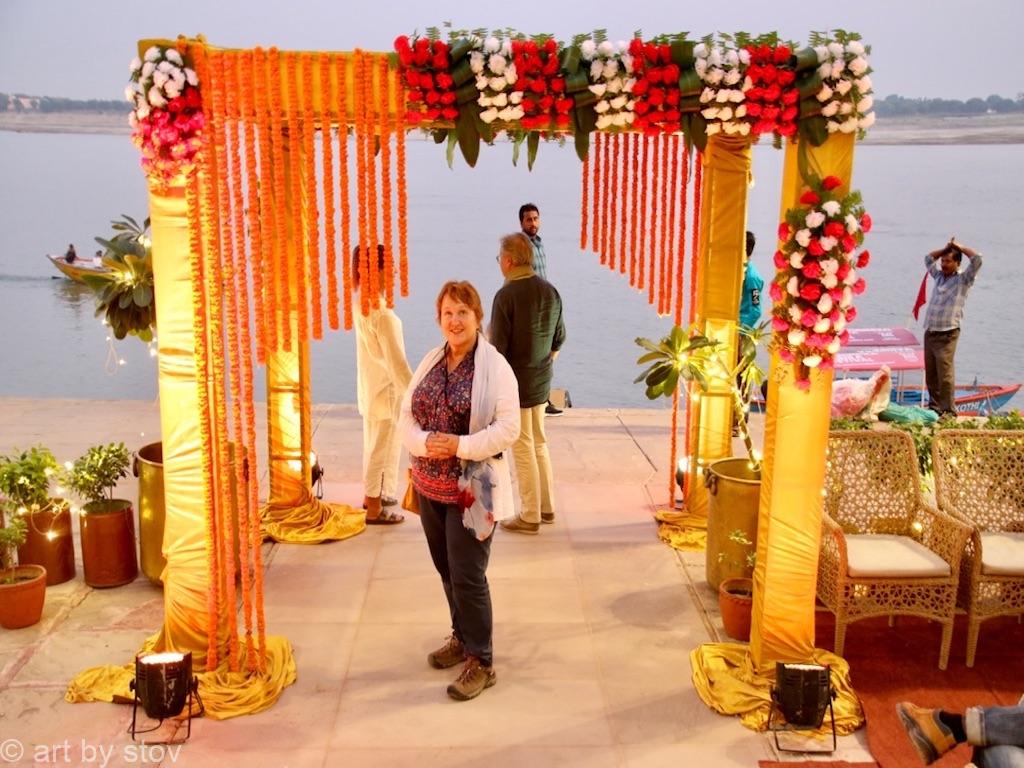
His job done, it was time to part with Big job Visnuth (?) I am sure it was to his great relief that he left us on the steps of the ghat to pick up his motorcycle; ironically he had to get back home to go shopping, doing the little jobs, with his wife!
We can’t believe we did all the above before breakfast, I had been elevated to a president of the United State Of America and the ever lovely reduced to the status of a little woman.
Straight up to the rooftop dining room for breakfast on the terrace overlooking the river. Service finished at 10:00 and it was now 09:30. I went for spicy Indian and The ever lovely had an omelette and fruit, washed down of course with masala chai.
After breakfast we retired to our room and had a little nap. We had little to do now until we went on the complimentary hotel boat ride up to the Aarti Puja at 17:30.
We woke about 12:00 noon and decided to go for a walk along the river’s edge. As we sauntered along we observed the Sadhus in their little niches in the walls.
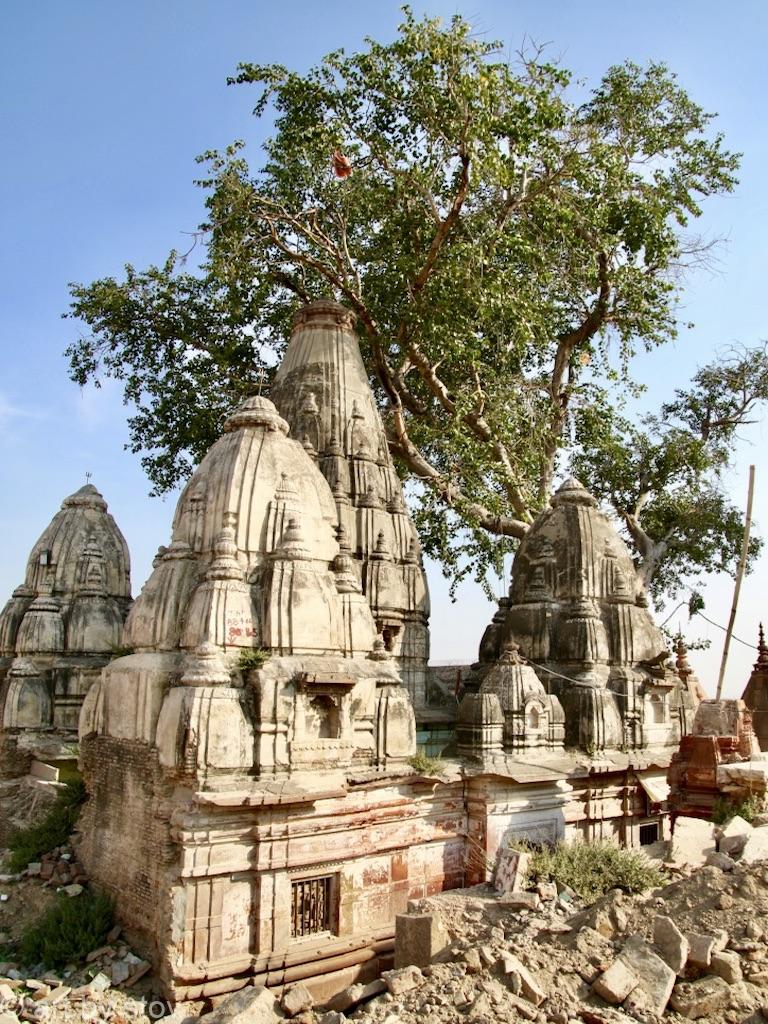
We headed up across the back of the burning ghat up into Modi’s strip. A calf had been born no more than an hour since it was most odd watching it lying there amongst the rubble. We walked away when the owner brutally manhandled the calf into the shade, a rather rough way to show concern for its welfare.
Cutting across we found a new way into the market passing on the way a grubby entrance to some shops going down to the river. I noted on the wall a sign to the Blue Lassi bar which is highly rated by our Rough Guide as being good value and a safe to place to eat. It looked filthy.
In the market now, we picked up a persistent hawker trying to sell his sister’s henna, he would not leave us alone even when I approached two policemen to ask for assistance he merely disappeared and then repaired a few feet down the lane. He eventually got bored having presumably spotted another Foreigner to hassle … to be honest there weren’t many of us.
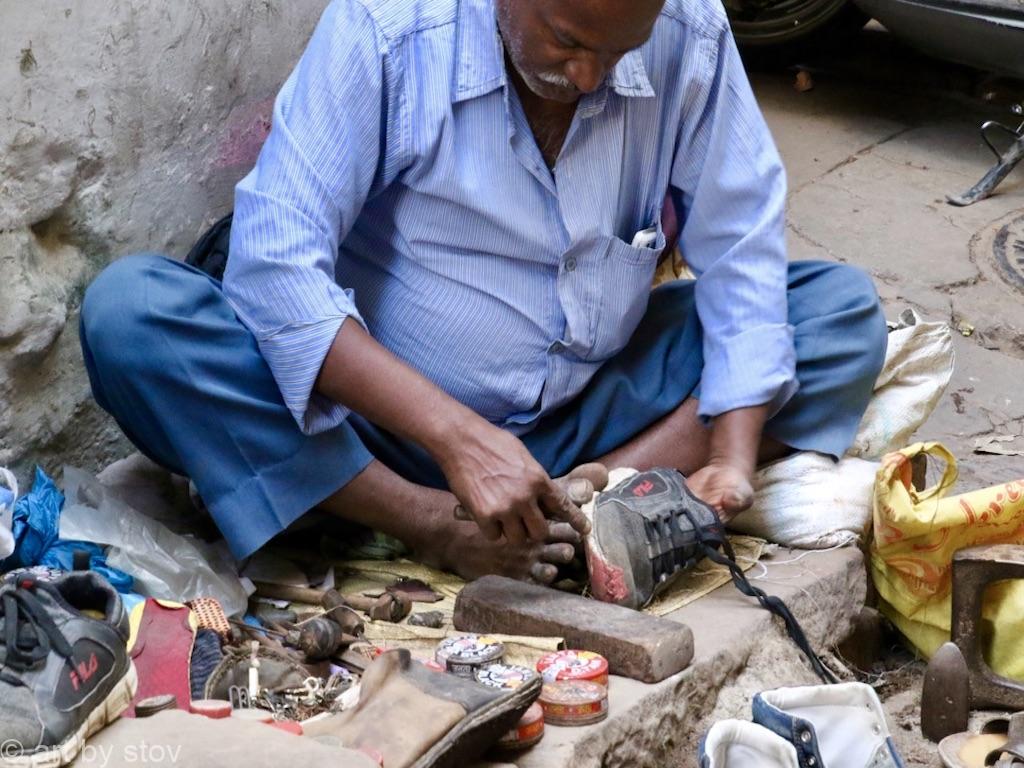
Entering the narrowest part of the market I commented to the ever lovely that with all the food around we hadn’t seen a rat anywhere. I spoke too soon. We had to step up onto a raised area at the side of the path to let a motorbike come through. As I was getting down I noticed a flatbread which had been dropped. As I looked again it moved. Studying it even more closely a rat was popping up from under the concrete and eating a hole through the bread.
We idled back to the hotel and decided to drink one of the 600ml bottled beers which we had Visnuth (?) buy us on the way from Sarnath after he told us the hotel was dry. It was so good we had the second as well. I was feeling slightly tipsy… when I looked at the bottle it was Kingfisher reserve and 7.2% proof….heady stuff indeed on an empty stomach and in 30c plus heat!
We made ready for the hotel boat to the aarti puja. Being powered by tonight diesel we got there quicker and therefore closer than the previous night. Using my Tamron travel lens (16 – 300mm ) i was able to take close ups of the ceremony, shooting at ISO 16000 and 1/300. We shared the boat with several friendly Spanish ladies, one of whose husband was seconded from Madrid; they had been living in Delhi for 5 years. The other was a visiting friend. The husband had not been outside of Delhi in the whole time he had been in India. What a fool!
Back for dinner. They bought us an amuse bouche of Crisp bread with green coriander sauce – no not coriander, green chilli thankfully I had eaten it before the ever lovely had a meltdown. We shared a murgh makhani, which tonight was too hot for the ever lovely and had little mint in it, jeera rice, some spinach and hot patty things and bindi du pyaza. All washed down with a 500ml can of beer each. To make up for the substandard curry the ever lovely had pudding, a walnut brownie made with cocoa not chocolate.
We crashed in the room at about 11:30 and set the alarms for a more reasonable wake up in the morning.
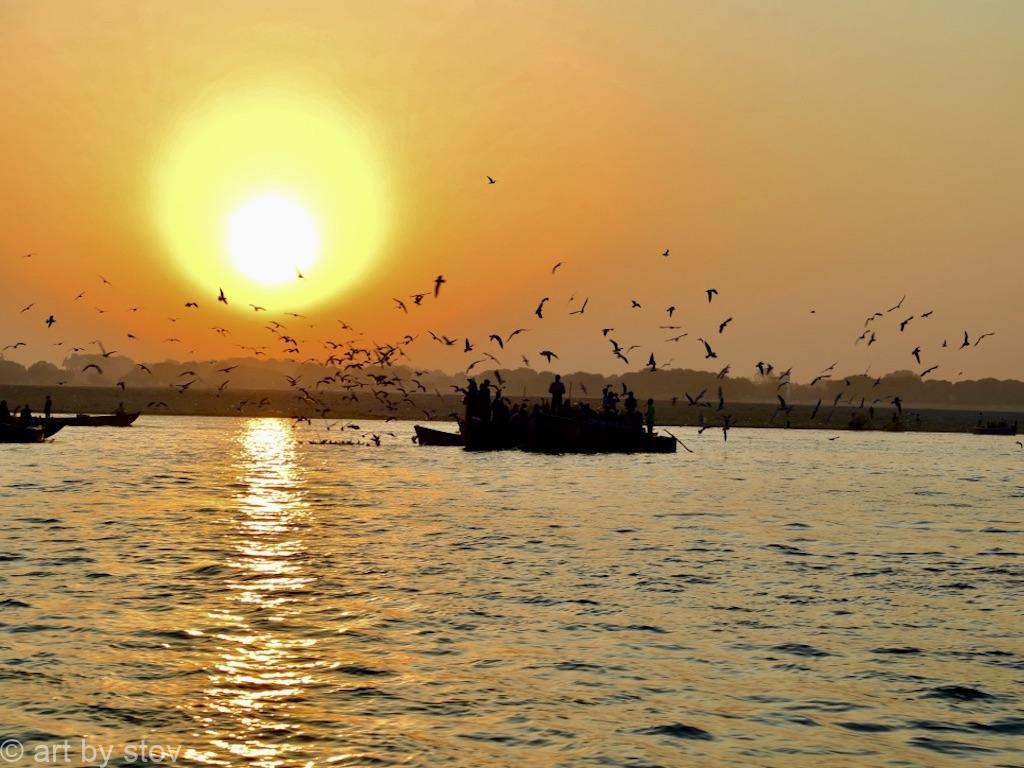
Join me next week – a stone’s throw from erotic temples and reaching Nirvana
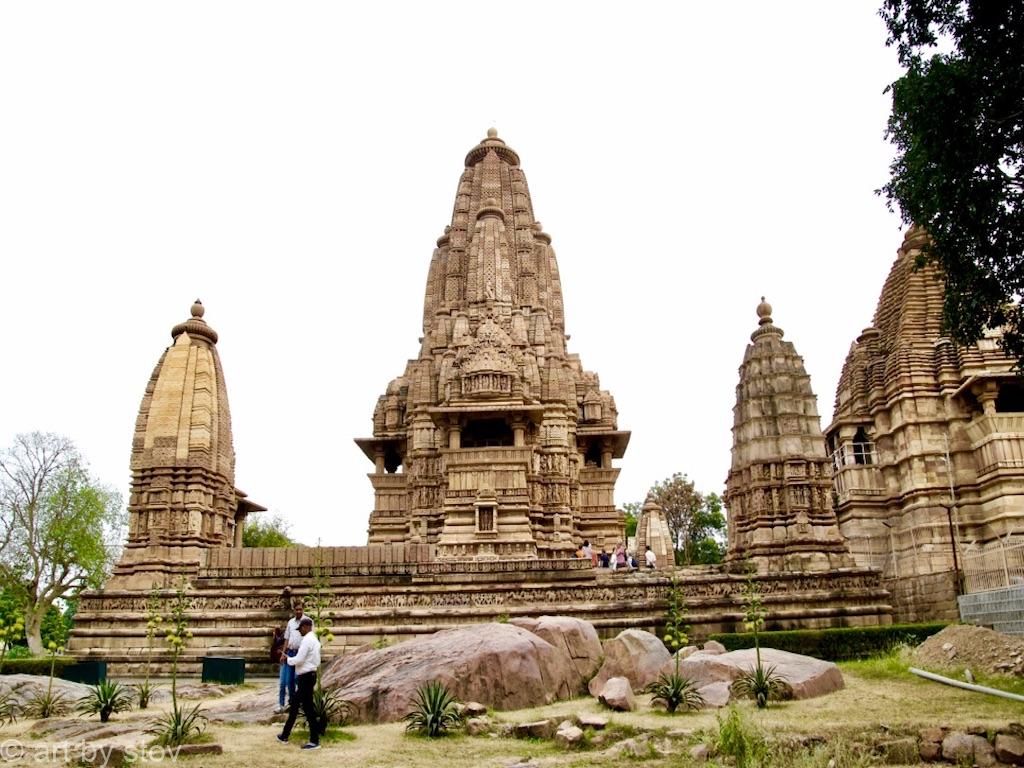
Missed an earlier Blog? Read about it here